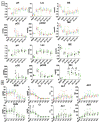Effect of Clemastine on Neurophysiological Outcomes in an Ovine Model of Neonatal Hypoxic-Ischemic Encephalopathy
- PMID: 38002819
- PMCID: PMC10670092
- DOI: 10.3390/children10111728
Effect of Clemastine on Neurophysiological Outcomes in an Ovine Model of Neonatal Hypoxic-Ischemic Encephalopathy
Abstract
Originally approved by the U.S. Food and Drug Administration (FDA) for its antihistamine properties, clemastine can also promote white matter integrity and has shown promise in the treatment of demyelinating diseases such as multiple sclerosis. Here, we conducted an in-depth analysis of the feasibility, safety, and neuroprotective efficacy of clemastine administration in near-term lambs (n = 25, 141-143 days) following a global ischemic insult induced via an umbilical cord occlusion (UCO) model. Lambs were randomly assigned to receive clemastine or placebo postnatally, and outcomes were assessed over a six-day period. Clemastine administration was well tolerated. While treated lambs demonstrated improvements in inflammatory scores, their neurodevelopmental outcomes were unchanged.
Keywords: asphyxia; brain hypoxia-ischemia; clemastine; neonates; ovine model.
Conflict of interest statement
The authors declare no conflict of interest. The funders had no role in the design of the study; in the collection, analyses, or interpretation of data; in the writing of the manuscript; or in the decision to publish the results.
Figures





